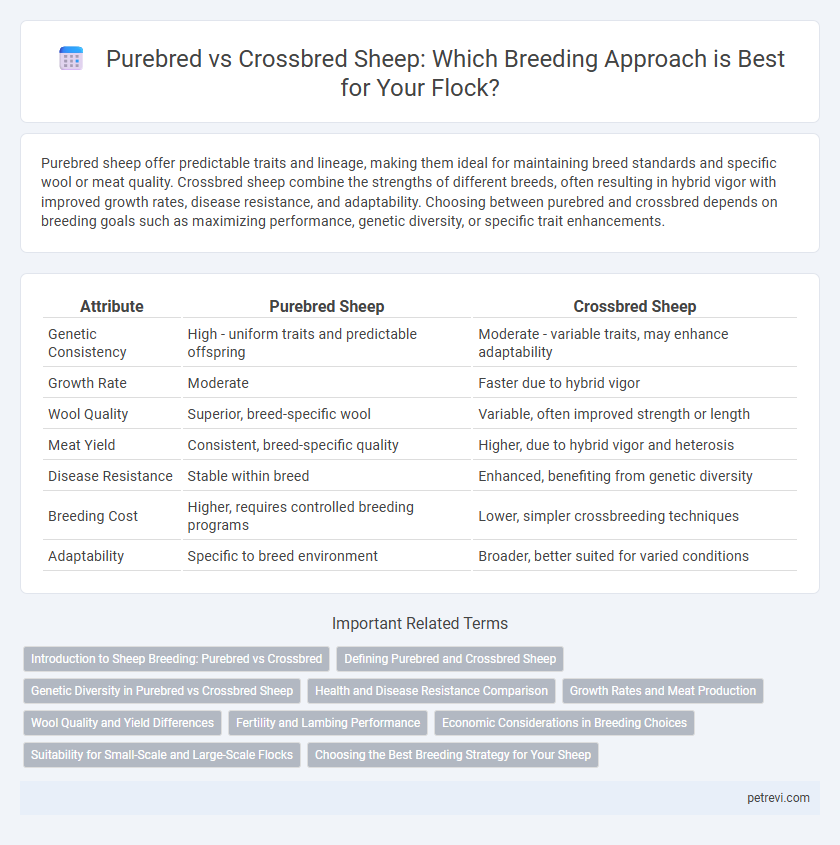Purebred sheep offer predictable traits and lineage, making them ideal for maintaining breed standards and specific wool or meat quality. Crossbred sheep combine the strengths of different breeds, often resulting in hybrid vigor with improved growth rates, disease resistance, and adaptability. Choosing between purebred and crossbred depends on breeding goals such as maximizing performance, genetic diversity, or specific trait enhancements.
Table of Comparison
| Attribute | Purebred Sheep | Crossbred Sheep |
|---|---|---|
| Genetic Consistency | High - uniform traits and predictable offspring | Moderate - variable traits, may enhance adaptability |
| Growth Rate | Moderate | Faster due to hybrid vigor |
| Wool Quality | Superior, breed-specific wool | Variable, often improved strength or length |
| Meat Yield | Consistent, breed-specific quality | Higher, due to hybrid vigor and heterosis |
| Disease Resistance | Stable within breed | Enhanced, benefiting from genetic diversity |
| Breeding Cost | Higher, requires controlled breeding programs | Lower, simpler crossbreeding techniques |
| Adaptability | Specific to breed environment | Broader, better suited for varied conditions |
Introduction to Sheep Breeding: Purebred vs Crossbred
Purebred sheep breeding involves mating animals from the same recognized breed to maintain specific genetic traits, ensuring uniformity in characteristics like wool quality, growth rate, and temperament. Crossbred sheep breeding combines different breeds to enhance hybrid vigor, resulting in improved disease resistance, fertility, and adaptability to diverse environmental conditions. Selecting between purebred and crossbred strategies depends on breeding goals, whether targeting consistency for commercial purposes or maximizing productivity and resilience through heterosis.
Defining Purebred and Crossbred Sheep
Purebred sheep are animals bred within a specific breed, maintaining a consistent genetic lineage and predictable traits such as wool quality, growth rate, and disease resistance. Crossbred sheep result from mating two different breeds, combining desirable characteristics from both parents to enhance hybrid vigor, improve fertility, and increase adaptability to diverse environments. Understanding the distinction between purebred and crossbred sheep is essential for targeted breeding programs aimed at optimizing productivity and sustainability in sheep farming.
Genetic Diversity in Purebred vs Crossbred Sheep
Purebred sheep exhibit limited genetic diversity due to inbreeding within closed populations, increasing susceptibility to hereditary diseases and environmental stress. Crossbred sheep benefit from hybrid vigor, combining diverse gene pools that enhance adaptability, fertility, and overall health. Maintaining genetic diversity in crossbreeding programs is essential for resilient and sustainable sheep breeding practices.
Health and Disease Resistance Comparison
Purebred sheep often exhibit consistent traits but may have limited genetic diversity, increasing susceptibility to certain diseases and inherited disorders. Crossbred sheep benefit from hybrid vigor, enhancing overall health and disease resistance by combining the strengths of different breeds. Studies show crossbreeding improves immune responses and reduces mortality rates in sheep populations.
Growth Rates and Meat Production
Purebred sheep often exhibit consistent growth rates and predictable meat quality, making them reliable for specialized breeding programs focused on uniformity. Crossbred sheep tend to demonstrate hybrid vigor, resulting in accelerated growth rates and improved meat yield compared to purebreds. Selecting the appropriate breed type depends on balancing the goals of maximizing growth efficiency and optimizing carcass characteristics for market demands.
Wool Quality and Yield Differences
Purebred sheep breeds are known for producing consistent high-quality wool with uniform fiber diameter, length, and crimp, which is essential for fine textile production. Crossbred sheep often yield greater fleece weights due to hybrid vigor, but their wool quality can be more variable, featuring a mix of fiber types and coarser textures. Breeders aiming for premium wool markets typically prefer purebreds, while those prioritizing quantity and adaptability may choose crossbreds to maximize overall wool yield.
Fertility and Lambing Performance
Purebred sheep often exhibit consistent fertility rates and predictability in lambing performance due to well-established genetics, whereas crossbred sheep typically demonstrate hybrid vigor, leading to enhanced fertility and higher lamb survival rates. Crossbreeding can improve reproductive efficiency by combining complementary traits, resulting in increased prolificacy and reduced lambing difficulties. Selecting breeding stock based on fertility metrics and lambing outcomes optimizes flock productivity regardless of purebred or crossbred status.
Economic Considerations in Breeding Choices
Purebred sheep offer consistent genetic traits that can command higher market prices for wool and meat, while crossbred sheep often exhibit hybrid vigor, leading to improved growth rates and disease resistance. Economic considerations in breeding choices include balancing the premium on purebred pedigrees against the lower production costs and increased profitability from crossbred flocks. Farmers must evaluate market demand, production efficiency, and long-term sustainability to optimize their breeding strategies for maximum economic return.
Suitability for Small-Scale and Large-Scale Flocks
Purebred sheep offer consistent traits, ideal for breeders prioritizing uniformity and specific breed characteristics in both small-scale and large-scale flocks. Crossbred sheep provide hybrid vigor, enhancing growth rates and disease resistance, making them well-suited for diversified farming operations seeking adaptability. Small-scale flocks benefit from purebred's predictability and crossbred's hardiness, while large-scale flocks optimize productivity through strategic crossbreeding programs.
Choosing the Best Breeding Strategy for Your Sheep
Purebred sheep offer genetic consistency and predictable traits, ideal for maintaining specific breed standards and enhancing wool or meat quality. Crossbred sheep provide hybrid vigor, improving growth rates, fertility, and disease resistance, making them suitable for diverse environmental conditions. Evaluating production goals and regional climate factors guides the selection of the optimal breeding strategy for your flock.
Purebred vs Crossbred for Sheep Breeding Infographic

 petrevi.com
petrevi.com